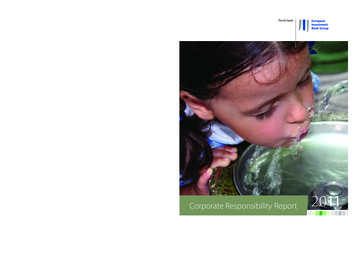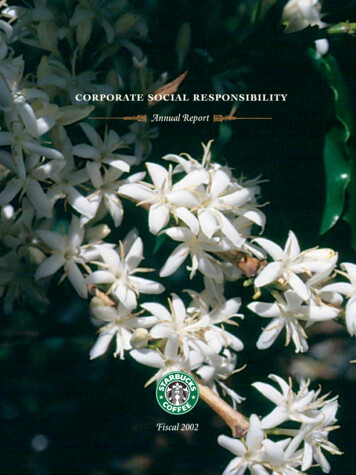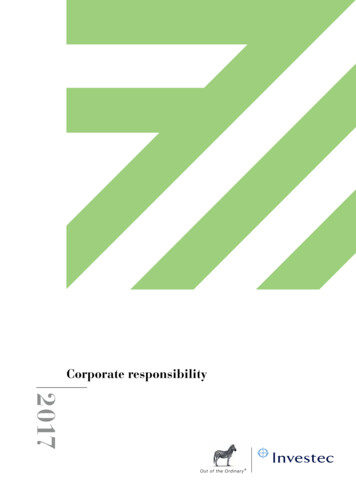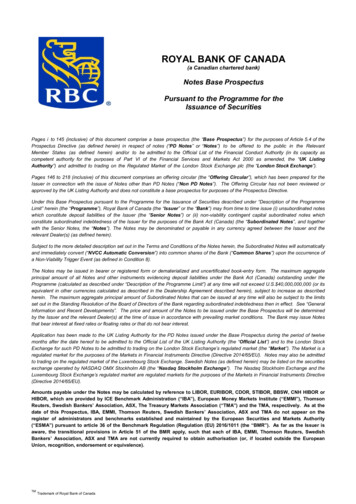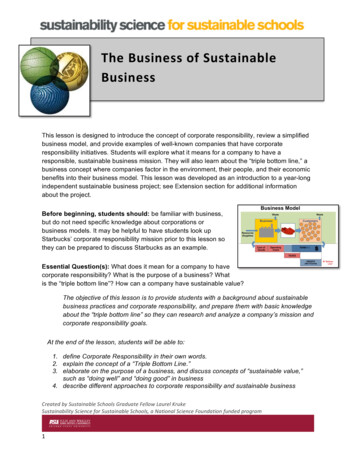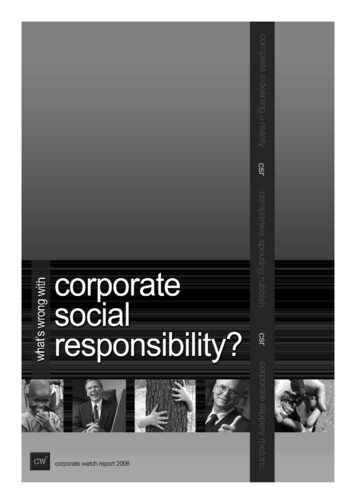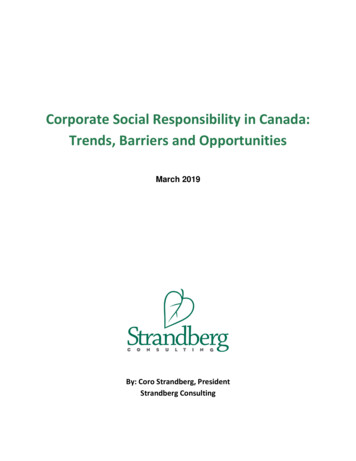
Transcription
Corporate Social Responsibility in Canada:Trends, Barriers and OpportunitiesMarch 2019By: Coro Strandberg, PresidentStrandberg Consulting
AcknowledgementsThis paper was researched and written with the generous support of others. In particular, Iwould like to thank the 32 companies that participated in the interviews and/or providedwritten submissions to the questions.I would also like to extend my gratitude to members of the Community Development andHomelessness Partnering Directorate (CDHPD), Employment and Social Development Canada(ESDC), for their significant support for drafting the interview guide, identifying interviewees,conducting the interviews, aggregating the notes and undertaking the initial analysis of thenotes and synthesizing the information. I extend my specific appreciation to Greg Graves,Manager, Sharmin Mallick, Policy Analyst, William Chen, Analyst, Luke Hansen, Senior PolicyAnalyst, Maurice Dikaya, Analyst, and Maya Nightingale, Analyst.This project received funding from the CDHPD of ESDC.About the AuthorCoro Strandberg is a recognized national leader in corporate social responsibility and socialpurpose. For thirty years she has advised business, governments and industry associations onstrategies to achieve social and environmental outcomes in the marketplace. She specializes insocial purpose, the circular economy and sustainable governance, human resourcemanagement, risk management and supply chain management. With 20 years of experience asa corporate director, Coro educates corporate directors and governance professionals onsustainable governance for the Director’s College and Governance Professionals of Canadarespectively. In 2015 she was named one of Canada’s Clean50 as the top CSR consultant inCanada for her impact. She publishes her thought leadership on her website atwww.corostrandberg.com.2
Executive SummaryThe Federal Government wants to understand trends and best practices in corporate socialresponsibility (CSR) and the roles it can play to accelerate and advance CSR in Canada. Itinterviewed over 30 companies with CSR programs in the fall of 2018, from across the country.Interviewees represented large and small companies, including multi-national corporations,from a diverse range of sectors. Participants were from publicly traded, private and cooperative companies, excluding Crown corporations. Nearly half of the companies indicatedthey had, or were developing, a social purpose or mission to state the reason for the company’sexistence – a purpose beyond profit. The company representatives interviewed were primarilyin senior CSR roles. This was a qualitative study to identify general trends and directions in CSRin Canada.The research revealed most respondents had a formal CSR approach, including goals, targetsand metrics embedded in a CSR strategy. It found there was a continuum of CSR practicesamong the respondents from a community investment focus to a social purpose businessmodel. Companies identified a shift in their CSR style over the past five years from ad hoc,incremental and transactional approaches, to strategic, social purpose-driven andtransformational models. CSR is undergoing a transition from “nice to do” drivers to “essentialfor business success” motivations. Further, several companies did not use CSR terminology andsaw it as an out-dated and irrelevant term.Companies are also evolving their relationships with their community partners. There appearsto be a continuum of practices from grant-based relationships on one end, to embeddedmodels at the other, in which the non-profit operates out of the business. Some companiescreate their own partnerships and charities to advance their social goals. There are a range ofmotivations for partnering, from it being the right thing to do, to recognizing that the companycannot achieve its social purpose on its own and needs partnerships to foster innovation andachieve success. Companies which have advanced on the partnering continuum seek othercompanies to partner with, and notice that peers and competitors can be reluctantcollaborators, as they seek competitive or marketing benefits only available through exclusivearrangements with non-profits. Companies expect to be involved in more long-term proactive,strategic partnerships in the future, in which they address systemic issues with non-profitorganizations and others. A barrier to this evolution is distrust of business within civil society,and a lack of capacity within non-profits, including knowledge of how to partner effectively withbusiness.3
Interviewees spoke to their efforts to leverage intermediaries to help them advance their socialinnovation and social purpose goals. There are diverse approaches to working withintermediaries: some companies are intermediaries, others leverage their partnerships asintermediaries, some partner with their intermediaries and others fund them. There were veryfew reported instances of the use of intermediaries to access non-profit partnerships.There was unanimous agreement that the government should play a lead role to accelerate andscale CSR in Canada. Two top ideas surfaced on its role: 1) the Federal Government couldconvene multi-stakeholder collaborations with the private and non-profit sectors to addresspriority issues, develop national social goals and a campaign, and possibly develop a nationalCSR strategy; and 2) it could create incentives to encourage take up, including recognitionprograms and awards, financial and tax incentives, social innovation challenges andgovernment CSR procurement. One cross-cutting finding speaks to the importance of impactmeasurement, and the desire for the Federal Government to support national efforts in thisarea.This qualitative study on CSR trends and best practices identifies a profound shift in how CSR isbeing practiced in Canada. CSR appears to be at an inflection point, in which the FederalGovernment can play a lead role to catalyze social and business success in the years ahead.4
Corporate Social Responsibility in Canada:Trends, Barriers and OpportunitiesBy Coro Strandberg, Strandberg ConsultingIntroduction and Purpose of ResearchThe Federal Government’s Community Development and Homelessness PartnershipsDirectorate’s Horizontal Policy Unit within Employment and“The government has a big role toSocial Development Canada conducted a study to scope out theplay in CSR. It is overdue.”current state of the Corporate Social Responsibility (CSR) field inCanada to determine key trends and best practices. The projectsought to enable the Government of Canada to identify ways in which it can accelerate andadvance CSR in Canada.For the purposes of the project, CSR is defined as a company’s approach to improving its socialand environmental performance and impacts. This study is particularly interested in acompany’s community impact, relations and partnerships, including social innovation.MethodologyIn November 2018, representatives from 32 companies known to have corporate socialresponsibility programs were interviewed by the Federal Government (one submitted itsresponse in writing). See the list of companies at Appendix A and the Interview Guide atAppendix C.An effort was made to include a diverse range of businesses from across Canada, including largeand small businesses with provincial and sectoral representation and national and globalcompanies operating in Canada.Nearly half (14) of the companies represented in the study are based in Ontario, with 11 fromBC. Four are from the prairie provinces, two from Quebec and one from the Atlantic provinces,specifically Newfoundland and Labrador. None are from the territories. Two-thirds of5
interviewees (24) are from large companies and one third (8) are from SMEs (small andmedium-sized companies with under 500 employees). Six are global multi-national companies.The financial services sector was represented by nine respondents (about one-third). Othersectors include Retail (5); Manufacturing (4), Real estate (4), Technology (3), Services (3), Food(2), Energy (1) and Health (1). Some notable sectors missing from the research include theResource and Entertainment/Travel/Tourism sectors.The corporate structure was evenly distributed, with 12 publicly traded companies, 13 privatelyheld companies and seven co-operatives, including credit unions. The research intentionallyexcluded crown corporations or government owned and operated entities.Almost half of the companies (14) indicated that they had, or were developing, a social purposeor mission as the reason for the company’s existence – a purpose beyond profit.A total of 36 people participated in the interviews, holding the roles of CEO (2), VP (4), Director(19), Manager (9), and Specialist (2). Over two-thirds held senior leadership positions (directorlevel and up). One-third held “sustainability” titles (12); eight have community investment,corporate citizenship or philanthropy roles; seven have titles related to CSR. Other titlesincluded “social purpose”, “community performance”, “impact”, “shared value”, “socialinnovation”, and “environment.” A small number held titles suggesting a more generic position(e.g. Legal and External Affairs) or unique roles (e.g. values-based banking).This report is a qualitative study designed to assess the state of play of CSR. As such,interviewee responses are analyzed for general themes. The sample size does not support thedrawing of definitive conclusions and the making of findings on statistical significance.However, the number and diversity of responses enables an overall assessment of CSR practicesand opportunities in Canada.FindingsQuestion 1: Current Approaches to Corporate Social Responsibility and GroundBreaking InitiativesCompanies were asked to provide a brief overview of their current approach to CSR, along withany examples they viewed/perceived as ground-breaking, novel or innovative.6
Highlights:Most companies have a formal CSR approach, including goals, values, targets, and metrics,which are embedded in a CSR strategy. However, it is important to note that a number ofcompanies do not use the term CSR to describe their efforts. Companies that don’t use CSRterminology answered this question from their non-CSR perspective.There appears to be a continuum of “CSR” practices among therespondents, from a community investment focus, to a CSRstrategy, to CSR integration and to social purpose. This wouldindicate that there is a trend to companies developing andintegrating a social purpose into their business models. For anumber of companies, CSR is seen as an outdated and no longerrelevant term.“We don’t have a formal “CSR”approach. We probably had a CSRapproach in the early and mid-2000s,when we had a “communityleadership strategy,” but we nowunderstand that we don’tcompartmentalize our work and wedon’t need a stand-alone CSRstrategy.”Using the language of CSR, eleven features were identified asindicative of the different CSR approaches, including: CSR board governance, strategy, embedment and reporting Social purpose business models Aligning CSR to the business Long-term CSR ambition to 2030 Engaging the value chain and industry on CSR Thought leadership on CSRThe range of community investment practices described by interviewees included donations,sponsorship, in-kind, surplus good donations, employee and skills-based volunteering,customer enabled and product-based giving, matched donations, cause-marketing andflagship/signature programs.Asked to describe innovative and ground-breaking examples of their CSR approach, companiesspoke to developing inclusive business models, generating social impacts from their products,leveraging non-profit expertise in product design, setting industry benchmarks, governmentcollaborations, engaging competitors and business customers on social innovation, andgenerating social good from technological applications.7
Detailed Findings:Most companies have a formal CSR approach, composed primarily of goals, targets and keyperformance indicators or metrics. Nearly all of these are embedded in a formal CSR strategy. Asmaller number indicated they have a CSR policy. A small minority did not have any of theseformal practices.Eleven features were observable from the description of the companies’ CSR approach. Theyare summarized in the following table.FeatureCSRgovernanceSocialpurposeCSR strategyCSRembedmentAligned tobusinessLong-termambitionValue mmunityinvestmentCSR ApproachBoard governance and oversight of the company’s social and environmentalcommitments, including a board sustainability committeeArticulation of a social purpose as the reason for the company’s existencewhich infuses the business modelCSR vision, values, policy, principles, strategy, goals, targetsEmbedment into corporate strategy, every business unit and decisions,culture, international operations, risk policiesUnderpins business model and business plans; aligned to the company’spurpose and its business imperatives; industry relevant, customer-centricLong-term sustainability strategy to 2030, with ambitious visionary goalsAddresses impacts along the value chain, up- and downstream of operations;addresses supplier and supply chain impacts; ensures suppliers are sourcingand producing responsiblyAdheres to standards and certifications, e.g. UN Global Compact1, B Corp2,Equator Principles3, Global Alliance for Banking on Values4, Fitwel5Reports on CSR progress and impactsProvides thought leadership in the industry and societyCommunity investments includes donations, sponsorship, in-kind, surplusgood donations, employee volunteering and skills-based volunteering,customer enabled and product-based giving, matched donations, causemarketing, flagship/signature ttp://www.gabv.org/5https://fitwel.org/28
In addition, a few companies spoke to their decentralized approach to CSR, in which CSRdirection is determined corporately but decisions are made locally. One company spoke to theirapproach to setting CSR priorities, which was to take long-term societal trends into account.Another described the maturation of their CSR program over 10 years, from a focus on gettingtheir house in order, becoming a catalyst for a sustainable society, to embedding sustainabilityfully into the organization. As well, a few companies mentioned their intent to follow a triplebottom-line approach to CSR, in which social, environmental and economic impacts andobjectives are taken into account.Notably, a significant minority commented that they don’t usethe term CSR and think it is an outdated approach: “CSR as a termis outdated”; “We consider ourselves post-CSR”; “We don’t usethe term CSR, our approach is to take the lens of sustainability”;“We use Environment, Social, Governance”.“We consider ourselves a socialchange organization using ourproducts to effect those changes.”Finally, a number of companies indicated they have adopted a social purpose as the reasonthey exist and build their social purpose into everything the company does. Those that havedone so are most likely to say they don’t use CSR terminology. They view social purpose as amore holistic approach to the business, in which the business model is infused with their socialintent and not treated separately.These findings suggest a continuum or pathway of CSR practice, as demonstrated in the figurebelow:CSR ContinuumLevelFocusLevel 1CommunityinvestmentLevel 2CSR strategyLevel 3CSR integrationLevel 4Social purposeAlmost half of the companies appeared to be at level 4: they indicated that they had, or weredeveloping, a social purpose or mission as the reason for the company’s existence.Innovations and ground-breaking examplesInterviewees described a number of CSR innovations and ground-breaking examples:9
Inclusive Business Models: Designing inclusive business models in which companies work toinclude vulnerable populations (e.g., as suppliers orproduct distributors), and help the company enter hard“We look seven generations ahead onto-reach markets or access scarce resources; seeking tohow to make things better. Ourhave products accessible to underserved (vulnerable)guiding question is: “who is left out,segments of the population through low-cost or freewhy, and how to change that”, that isservicesour purpose and identity. OurSocial Products: Leveraging products to contribute to thecompany is the vehicle for change andsocial goals; having products which enable social progressprofitability is the fuel.”and are 100% sustainable; partnering with non-profits andnon-governmental organizations to design socially usefulproducts; having products which have sustainability targets which are robust, evidencedbased and internally verifiedIndustry Leadership: Setting an industry benchmark; establishing bold goals that wereadopted by other companies; developing and sharing tools such as a social purpose gapassessment tool that defines best, leading and next practices in social purpose andcorporate social responsibility to assess progress and address gapsCollaboration: Collaborating with all levels of government, and with the industry (includingcompetitors to advance social innovation)Customer Engagement: Sharing social innovation with business customers and encouragingtheir engagementSocial Technology: Inventing new technologies that can be used for social good andpartnering with government and community groups to make the technology available (“Wewant to understand who will and will not have access to technology”)Company Profile:“Our approach to CSR is centered around our company’s purpose. We have three areas offocus, and we feel that if we source our products responsibly, protect the environment andfrom across Canada, then we feel we can contribute positively to Canadians’ lives daily and inthe future, and in the products we provide. We prioritize things within those three pillars:environment, sourcing and community. We look at urgency of the issue, relevance to ourcompany, can we actually move the needle and the needs of our consumer. We have severalinputs too: we look at benchmarking, look at what our competitors are doing, we look abroadas well, and we do our own CSR research every day, and with our customers and the customersof our competitors. We combine that with our strategic business imperatives and long-termtrends. We post our results online, and we message through press releases and signage up instores, etc. That’s how we communicate to our consumers.”10
Company Profile:“Essentially, our purpose is not to earn profits and then do good social projects. We want toearn profits by doing good things in the first place. Our purpose is to grow prosperity. In thisway, everything we do needs to be good for the customer, the environment, and society. Wethink of ourselves as a social enterprise, which is not just a term for non-profits.”Company Profile:“We haven’t used the term CSR for a long time. We are a social purpose business. Thedifference between a social purpose business and a business with a CSR program is that a CSRprogram is bolted on. CSR programs thus have an indirect connection to the business whereassocial purpose businesses have mechanisms that address social purpose holistically. All ourprograms are tied into supporting that social purpose which is generally geared towardsimproving the community or society and that’s how we operate. Our social purpose is linkedinto our mission and our value statement, the overlap is pretty much the entire thing. So,everything is aligned that way.”Company Profile:“We are a hybrid organization that is part cooperative and part free enterprise, so we are notcapitalist in our approach. We consider ourselves to be a meritocracy and take a shared-valueapproach. Using the Mondragon Corporation (a federation of worker cooperatives based in theBasque region of Spain, founded in the town of Mondragon in 1956 by graduates of a localtechnical college) as our model, we are an employee cooperative founded on social justiceprinciples and aim to generate both profit and social responsibility.”Question 2: Recent CSR ShiftsInterviewees were asked if and how their company’s approach to CSR has shifted in the pastfive years.Highlights:CSR is a very dynamic undertaking. Most interviewees commented on how their companies’approach to CSR had shifted in the past five years.11
Main shifts include a transition from ad hoc, transactional and incremental approaches to thosewhich are strategic, holistic, social purpose-driven and transformational. Other top shiftsinclude a focus on integrating CSR into the business model, a shift away from CSR strategies tosocial purpose business models, and a shift to becoming data-driven and actively measuring,tracking and disclosing social impacts. There is a shift from thinking of CSR as the socialresponsibility of business, to a way of doing business, and along with that a shift from thinkingof CSR as a “nice to do”, to CSR is “essential for business success”.Companies are starting to mature in their stakeholderengagement programs, from using their balance sheetsfor good, to identifying ways to advance their businessso that society benefits as well and collaborating forsocial impact, to using industry CSR standards todetermine CSR priorities.Community investment approaches are undergoingtransitions as companies learn from their earlyexperiences: they are leveraging more resources thanjust grants and employee volunteering and looking topartner strategically with non-profits on higher-impactefforts.“Our approach to CSR has notfundamentally changed in the pastfive years. However, the topic of itsfocus has changed. For example, fiveyears ago our focus was on cancerand now it is on cardio vasculardisease using a gender-based lensthat recognizes the differencesbetween men and women. A reasonfor this change was the recognitionthat cardio vascular disease wasidentified as the most serious threatto women’s health.”Detailed Findings:Most responded that their CSR approach had shifted in the past five years. Some spoke to thepast approach and how it had transitioned to the current model, as set out in the table below:ApproachMeasurementPastDonations only, no strategy,measurement or partnershipsStrategyScattered and ad hocComprehensive PhilanthropicPurposeCorporate citizenshipImpactTransactionalPresentStrategy, metrics, targets, partnershipsStrategicHolisticSocial purpose business modelTransformationalSome commented on the drivers of the shifts, which primarily included a greater focus onstakeholders, more stakeholder demand, and impact evaluations.Only one mentioned how the company hadn’t undergone any shifts, and another personmentioned they were too new to comment on past shifts. A few commented that the shiftswere still underway and were not final or complete. A few observed that the shifts were not12
substantial, but rather continuous improvement and a change in priority (see text box for anexample of this).ShiftsThe top shifts identified in declining order of mentions are a shift to integrating CSRconsiderations throughout the business, a shift to developing and implementing a socialpurpose, a shift to becoming more data-driven, and a shift in community investment practices.These shifts are described below, along with other shifts mentioned by the interviewees.Integration: Companies are embedding sustainability into all their business decisions. “It is nolonger separate but integrated into corporate strategy, so it is not on the side any longer, buthow we do business.” Companies are including CSR in the roles of HR and finance and otherfunctions. One is integrating CSR in its annual report, so that it reports on financial and nonfinancial results in one disclosure. Another is including its CSR priorities in its project portfolioand risk register (see text box for more details).Company Profile:“To ensure holistic development and sustainment of physical assets, we created processes thataim to incorporate environmental and social aspects such as water use, air emissions, energyuse, human rights, and stakeholder and Aboriginal relations into new projects. The purpose ofsustainability integration into our process for developing physical assets, is to ensure:environmental and social risks are identified as part of the project definition, developmentoptions are evaluated against environmental and social risks through the concept selectionprocess, environmental and social risks are incorporated into the project’s risk register, and ourproject portfolio is in line with our strategic sustainability goals and vision over the long-term.”Social Purpose: A number of companies are developing and implementing their social purpose– the company’s humanitarian reason for being – and using this to set their social priorities.Data-Driven: A number of companies are taking a data-drivenapproach, improving the ways in which they track, measure,and collect data, and using data management to inform theirCSR strategy. Related to this approach, companies aremeasuring the impact of their work and increasing their CSRdata collection.“Previously we did not have a formalCSR approach; provided donationswith no strategy / measurement / orpartnerships. We evolved to identifywhat we stand for. We now have aCSR budget for partnering, formeasurement and for impact.”Community Investment: A few companies commented on theshifts they had seen in their community investment efforts.This included a shift from pro-bono work to providing grants, a shift from grants to morestrategic hands-on partnering, and to providing greater access to resources such as space,13
employees and other assets, and a shift from supporting many non-profits in a non-impactfulfashion to partnering with a reduced number of non-profits on higher impact activities.New Focus: There was reference by some to a new focus on carbon, to greater board oversightof climate change, to becoming carbon positive (taking carbon from the atmosphere, ratherthan simply reducing the company’s carbon footprint) and to setting more ambitious carbonreduction targets. On the social side, one company spoke to a new focus on health and wellnessof its employees and customers.CSR Budget: A few companies mentioned how they now had a CSR budget and funding, whichresulted in them moving away from ad hoc measures to becoming more strategic.CSR Intent: A few companies commented they had identified what they stood for, whichresulted in an increase in intentional giving and partnering than in the past.Other shifts included: Set targets and benchmarks: “In the past we used to be very best practices based, butnowadays, we’re focused on our targets and how we meet the metrics we’re trying totarget”Further alignment of social innovation to their business objectives, so that it is “more than aresponsibility, but a way of doing business”Decentralization: “We are moving from a centralized to a decentralized approach to CSRand will continue to do so as it has been successful in achieving greater positive socialimpact”Company-wide recognition that CSR is not a “nice to do” but is required for business successand performanceMaturation in stakeholder engagement and degree to which the company addressesstakeholder needsShift to using balance sheet for good: “We realized“As opposed to cranking upthat we have a lot more ability to make a difference marketing, our aim has been to buildif we use more of our balance sheet; we recentlycapacity within our community tocarved out a portion to start impact investing”support our social purpose.”Shift to a “shared value” approach, in which thecompany looks for ways it can benefit society whileit invests in measures that benefit its business. In this way, shareholders profit when thecompany benefits societyShift to greater collaboration on social impactStarted using a global industry standard to assess practices and identify gaps; this is beingused in conversations with senior management14
Question 3: UN SDG Awareness and ActivityInterviewees were asked if they were aware of the United Nations Sustainable DevelopmentGoals (UN SDGs), and if so, whether their firm was addressing them, and in which ways they didso. All the interviewees were aware of the UN SDGs, with all but one addressing them (orplanning to) to varying degrees and in various ways. (See UN SDG Chart at Appendix B and atthis Link.)Highlights:There is a continuum of engagement on the UN SDGs, from no impact to high-impact, as set outin the table below.Continuum of UN SDG EngagementNo Activityon the SDGsEducate Staff, SDGs InformAssessCSR StrategyAlignment on and Reportthe SDGsNo impactExternalEngagementon the SDGs(Customers,Sectors)SDGs InformCorporateStrategySDGs InformCorporatePurpose andBusinessModelHigh impactDetailed Responses:The following is a summary of the different approaches to activating on the SDGs as describedby the companies.1) Assess alignment of CSR strategy to SDGsThis was a very common method among the companies. Many have engaged in initiatives toidentify the links between their CSR strategies and the SDGs and are conducting exercises tocross-reference their current approaches to the Goals. While this practice does not lead togreater investment in the SDGs, it does enable communication as pointed out by a few of theinterviewees. By going through this exercise, companies can communicate to stakeholders howtheir existing CSR efforts are related to the SDGs.15
2) Use SDGs as a lens to set priorities on CSR strategyUsing SDGs as a lens to set priorities on the CSR strategy was a second common practice. Anumber of companies report they used the SDGs to prioritize their CSR initiatives. Oneinterviewee commented that “We went through a mapping exercise to identify what we can doto support the SDGs and
strategies to achieve social and environmental outcomes in the marketplace. She specializes in social purpose, the circular economy and sustainable governance, human resource management, risk management and supply chain management. With 20 years of experience as a corporate director, Coro educates corporate directors and governance professionals on
